The method of hydroponic plant growth has gained popularity for its efficient use of nutrient-rich water instead of soil. Despite its benefits, hydroponics is not without its challenges.
Hydroponic plants wilting is a very common problem, and it causes serious trouble to the gardeners. Even I have faced this issue in the past.
Honestly speaking, hydroponic growers face wilting problem quite frequently and it is caused by nutrient imbalances, pests, and other factors. That’s why in order to maintain healthy hydroponic plants and maximize their potential, it’s crucial to understand and address wilting.
Let’s explore its causes and how to prevent and treat it.

Table of Contents
Common Causes of Hydroponic Plants Wilting
Well, it’s no secret that droopy plants can be a real downer. However, before we start dishing out solutions, we need to get to the root of the problem. Here are some frequent culprits behind hydroponic plant wilting:
Water-related causes
Wilting in hydroponic plants is often linked to water-related issues. Maintaining a consistent and balanced water supply is crucial.
Wilting can occur when plants are not receiving enough water or when they are overwatered. It is important to find the right balance. Poor water quality can also contribute to wilting. Hard water or high chlorine levels can damage plants and cause them to wilt.
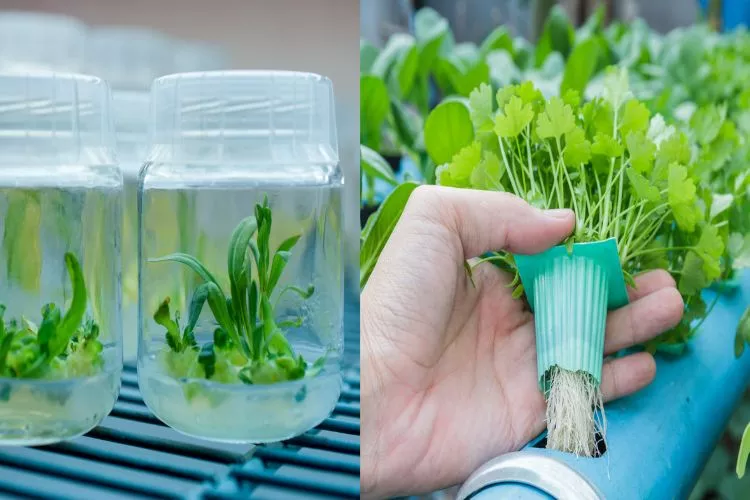
Nutrient-related causes
Disproportionate nutrient levels often result in the wilting of hydroponically-grown plants. For these plants to flourish, they depend on the accurate balance of nutrients. An insufficiency or excess of specific nutrients may lead to wilting.
Take nitrogen as an illustration. It is a crucial element for plant development and generates chlorophyll, indispensable for photosynthesis. A scarcity of nitrogen might hinder plants from producing enough energy for growth, causing them to droop.
Conversely, excessive nitrogen can trigger accelerated growth, making the plant top-heavy and prone to wilting. Furthermore, an abundance of nitrogen can disrupt the balance of other elements like potassium and calcium, contributing to wilting.
Similarly, inadequate or excessive amounts of other nutrients can lead to wilting. For instance, a lack of phosphorus can result in stunted growth and wilting, which is critical for root growth and energy generation. On the flip side, an excess of phosphorus can create an imbalance in other nutrients, causing wilting.
Other vital elements for plant growth, such as potassium, calcium, and magnesium, can also cause wilting when not available in the correct proportions. Hence, keeping a close eye on nutrient levels and making necessary adjustments to avert wilting is crucial.
pH-related causes
Another crucial aspect of hydroponic plant well-being is the pH value of the nutrient mixture. pH indicates the acidity or basicity of a solution and can substantially influence plant growth.
In hydroponic environments, it is essential to sustain appropriate pH values to guarantee efficient nutrient absorption for your plants.
A pH value that is too low (acidic) may result in the accumulation of specific nutrients like aluminum, manganese, and iron, which can harm plants. This can lead to wilting, hindered growth, and even the plant’s demise.
In contrast, a pH value that is too high (alkaline) can result in a deficiency of nutrients like iron and manganese, also causing wilting.
The ideal pH range for hydroponic plants may vary according to the cultivated species, but it usually lies between 5.5 and 6.5. Monitoring and adjusting pH levels as needed is crucial to maintaining plant health.
To modify your pH levels, you can use pH-increasing or pH-decreasing solutions, usually made from acids or bases that can elevate or reduce the pH value of your nutrient mixture. Alternatively, a buffering agent can stabilize the pH value and minimize fluctuations.
Besides keeping an eye on the pH value, monitoring the nutrient solution’s conductivity is essential, a measure of the total dissolved solids. Conductivity can impact pH value and nutrient absorption, so maintaining it within the recommended range for your plants is vital.
Environmental causes
The surroundings of hydroponically cultivated plants can influence their well-being as well. For instance, extreme temperatures, either too hot or too cold, can stress plants, leading to wilting.
Elevated humidity levels may also result in wilting by promoting mold and mildew growth. In the same vein, insufficient light exposure might cause plants to droop.
Pest and disease-related causes
Pests and diseases can have a significant impact on hydroponic plant health, and they can cause wilting, stunted growth, and even plant death if left untreated. Here are some examples of common pests and diseases that can cause wilting in hydroponic plants:
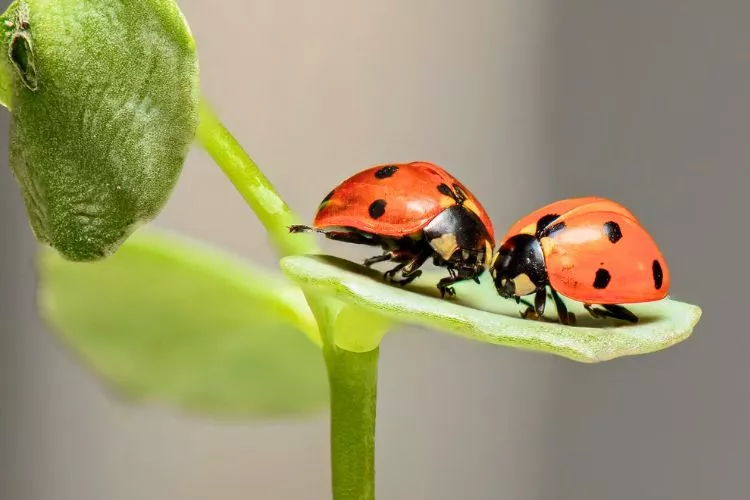
Pests
- Spider mites: These minuscule pests frequently trouble hydroponic systems and can rapidly increase, inflicting considerable harm to plants. They feast on plant leaves, leading to yellowing and discoloration. Over time, this results in wilting and hindered growth. To avert spider mite invasions, it’s crucial to regularly inspect plants and respond immediately upon detecting any signs of infestation.
- Aphids: Another prevalent issue in hydroponic systems is that aphids can cause wilting and stunted growth by consuming plant sap. These pests can quickly multiply and spread throughout the hydroponic system, making it vital to consistently check plants and act promptly upon discovering an infestation.
- Whiteflies: These tiny, winged insects can damage hydroponic plants considerably. Feeding on plant sap, they cause yellowing, wilting, and hindered growth. Moreover, whiteflies can transmit diseases to plants. Consequently, it’s essential to routinely examine plants and take appropriate measures to identify any signs of infestation.
Diseases
- Pythium: Pythium is a widespread fungal ailment that can result in wilting, yellowing, and hindered growth in hydroponic plants. This disease flourishes in damp environments, making it essential to manage appropriate water levels and guarantee sufficient ventilation in your hydroponic setup.
- Fusarium: Another fungal affliction, Fusarium, can lead to wilting and stunted growth in hydroponic plants. Often transmitted via tainted soil or water, it is vital to carefully observe your plants and implement measures to halt the spread of this disease.
By monitoring your plants regularly and taking action at the first sign of a problem, you can prevent pests, diseases, and environmental factors from causing wilting in your hydroponic plants.
Root-related causes
Problems associated with roots can also lead to wilting in hydroponic plants. In hydroponic setups, root issues can rapidly propagate, inflicting considerable harm on your plants. Below are some typical root-related factors that contribute to wilting in hydroponic plants:
- Root rot: Root rot is a fungal disease that can cause wilting, yellowing, and stunted growth in hydroponic plants. It’s often caused by poor water management or inadequate ventilation, which can create moist conditions for fungi to thrive in. To prevent root rot, it’s important to maintain proper water levels and ensure adequate ventilation in your hydroponic system.
- Root diseases: Various root afflictions can lead to wilting in hydroponic plants. For instance, Phytophthora root rot is a condition triggered by a fungus-like organism that targets plant roots. This ailment can result in wilting, yellowing, and hindered growth in hydroponic plants. To avert root diseases, it’s essential to manage appropriate water levels, guarantee sufficient ventilation, and utilize disease-resistant plant types.
- Root damage: Root damage can also cause wilting in hydroponic plants. This can occur from various causes, such as rough handling during transplanting, damage from pests or diseases, or even damage from high nutrient concentrations. To prevent root damage, handling your plants carefully, monitoring for pests and diseases, and maintaining proper nutrient levels is important.
Symptoms of Wilting in Hydroponic Plants
Wilting is a frequent issue faced by hydroponic cultivators and can result from various causes, including water-related concerns, disproportionate nutrients, environmental influences, pests and illnesses, and root-associated troubles.
Below are some typical indicators of wilting in hydroponic plants.
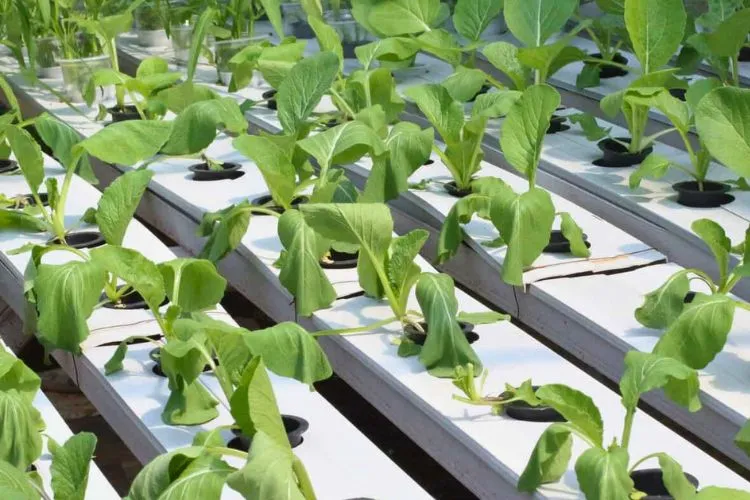
wilting leaves
One of the most common wilting symptoms in hydroponic plants is wilting or sagging leaves. Different types of leaf wilting can indicate different problems:
- Downward-curling leaves can indicate overwatering, nutrient deficiencies, or root problems.
- Upward-curling leaves can indicate heat stress, nutrient excesses, or pest damage.
- Wilting leaves that are dry, or crispy can indicate a lack of water or high heat.
By identifying the type of leaf wilting and the underlying cause, you can take appropriate action to address the problem and prevent further wilting.
Yellowing or browning of leaves
Another common symptom of wilting in hydroponic plants is the yellowing or browning of the leaves. Nutrient imbalances or deficiencies can cause this, as environmental factors such as high heat or low light or pest and disease damage. Nutrient-related leaf discoloration can include:
- Nitrogen deficiency: Yellowing of older leaves, while younger leaves remain green
- Iron deficiency: Yellowing between leaf veins, while veins remain green
- Phosphorus deficiency: Red or purple coloration in leaves, with stunted growth
- Calcium deficiency: Brown or black spots on leaves, with a distorted growth
Other causes of leaf discoloration include pH imbalances, high heat, pest and disease damage, and nutrient excesses.
Stunted growth
Wilting can also cause stunted growth in hydroponic plants. Causes of stunted growth can include:
- Nutrient deficiencies or excesses
- Root problems or damage
- Overwatering or underwatering
- Environmental factors such as low light or high heat
Prevention and treatment of stunted growth can include monitoring and adjusting nutrient levels, inspecting roots for damage or disease, maintaining proper water levels, and providing appropriate environmental conditions for your plants.
Wilting stems
In severe cases of wilting, the stems of hydroponic plants may also start to wilt and droop. Causes of stem wilting can include:
- Lack of water or nutrients
- Root damage or disease
- Environmental factors such as low humidity or high heat
Prevention and treatment of stem wilting can include:
- Maintaining proper water and nutrient levels.
- Inspecting roots for damage or disease.
- Providing appropriate environmental conditions.
- Taking prompt action at the first sign of wilting.
Prevention and Treatment of Wilting in Hydroponic Plants
One of the most important aspects of growing healthy hydroponic plants is preventing and treating wilting. Here are some tips for maintaining healthy plants and addressing wilting when it occurs:
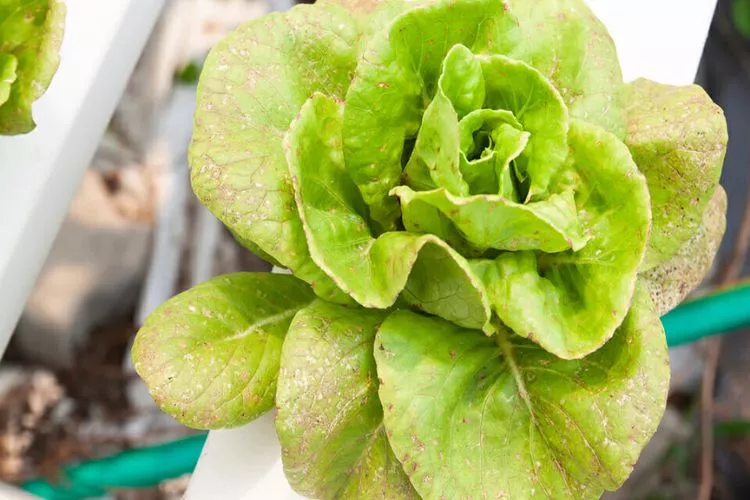
Maintaining proper water levels
The primary action in upholding correct water levels involves accurately measuring the water. This can be accomplished using a water level gauge or by inspecting the water level present in the reservoir.
Various techniques can be employed to maintain proper water levels, such as utilizing an automated irrigation system or watering by hand. An automated irrigation system can be configured to water plants at specific intervals, ensuring they receive the correct amount of water.
Hand-watering provides more control over the water quantity plants receive but can be labor-intensive.
Various techniques can be used to uphold appropriate water levels, such as utilizing an automated irrigation system or watering by hand.
An automated irrigation system can be configured to water plants at particular intervals, guaranteeing they receive the correct quantity of water. Hand-watering offers more control over the water volume plants receive, but it can be labor-intensive.
Monitoring nutrient levels and pH balance
A crucial aspect of preventing wilting in hydroponic plants is upholding appropriate nutrient levels and pH equilibrium. This entails consistently observing the nutrient levels and pH balance in the solution where plants grow.
Nutrients are vital for plant growth and must be supplied in the right quantities to flourish. Insufficient or excessive amounts of a specific nutrient can lead to issues, including wilting. For instance, if a plant lacks adequate nitrogen, its leaves might turn yellow and eventually droop.
Monitoring the pH balance is also essential since plants need a particular pH range to absorb nutrients effectively. Plants may struggle to absorb necessary nutrients if the pH is excessively high or low, resulting in wilting.
Various methods can be employed to observe nutrient levels and pH balance, including pH strips, pH meters, and conductivity meters. pH strips are a budget-friendly option, providing a rough pH level estimate. pH meters and conductivity meters offer more accuracy but can be costlier.
In order to maintain appropriate nutrient levels and pH equilibrium, adjustments to the solution are necessary. This might involve supplementing more nutrients or altering the pH using products like pH up or down.
Adhering to the manufacturer’s guidelines and utilizing protective gear such as gloves and goggles is essential when making adjustments.
Providing adequate ventilation and temperature control
Adequate ventilation guarantees that plants receive a sufficient fresh air supply and help to avoid excessive moisture accumulation in the growing area. Temperature regulation is vital as it impacts plant growth and metabolism, and extreme temperatures can result in wilting.
One approach to ensuring proper ventilation and temperature management in hydroponic systems involves fans and vents. Fans can circulate air and generate a mild breeze, strengthening plant stems and preventing stagnant air buildup.
Vents can help regulate temperature and humidity levels in the growing space by letting fresh air in and expelling hot, humid air.
Consistent monitoring of temperature and humidity levels is crucial, with necessary adjustments made accordingly. Ideally, daytime temperatures should range between 68-75°F (20-24°C), with slightly cooler temperatures at night. For most hydroponic plants, it is best to maintain humidity levels between 50-70%.
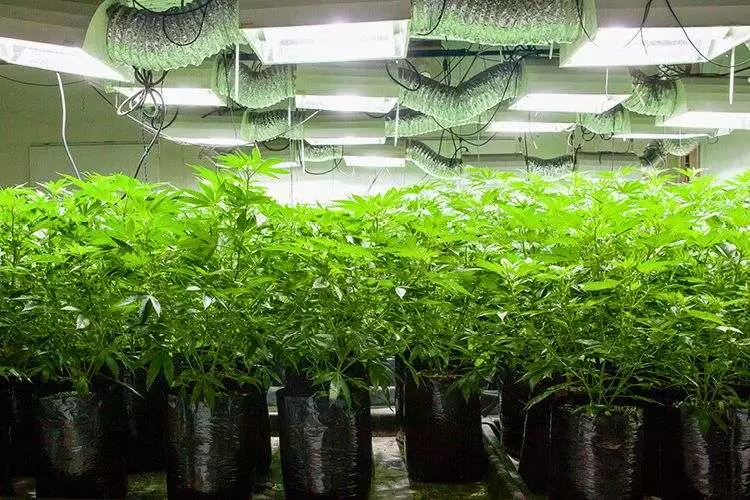
An alternative approach to regulating ventilation and temperature is employing air conditioning systems or heating devices.
These can help sustain a uniform temperature within the grow room, irrespective of external climate conditions. Nonetheless, verifying that these systems are suitably sized for the grow room and positioned at a safe distance from the plants is crucial to prevent any harm.
Additionally, maintaining proper air circulation within the growing area is crucial. This can be achieved by strategically placing fans and vents to establish a gentle airflow throughout the room. This helps prevent stagnant air and excessive humidity buildup, which can lead to wilting.
Regularly inspect plants for pests and diseases
Regularly inspecting your plants allows you to catch any signs of pests or diseases before they become a significant problem.
To inspect your plants, start by visually examining the leaves, stems, and roots for any unusual discoloration, spots, or pests. Check the undersides of the leaves, where pests tend to congregate and inspect the root system for any signs of rot or damage.
If you notice any pests or diseases, it’s crucial to address them immediately to prevent wilting and further damage to the plant.
One effective method is to use organic pest control measures, such as neem oil or insecticidal soap, to eliminate pests. Chemical pesticides can also be used but should be used cautiously and according to the manufacturer’s instructions.
Treating root problems with appropriate solutions
Root issues can occur due to various factors, including nutrient shortages, excessive watering, or infectious agents. Since roots serve as the primary water and nutrient absorption method in hydroponic setups, maintaining their health and functionality is vital.
One efficient method to address root issues is by utilizing suitable treatments. Multiple organic and chemical treatments are available to tackle different root-related problems.
For instance, if roots suffer from a fungal or bacterial infection, applying a fungicide or bactericide might be essential. Conversely, if roots are experiencing nutrient scarcity, a nutrient solution could be necessary.
Before applying any solution, it’s crucial to identify the root problem before applying any solution. This can be done by examining the roots for any signs of discoloration, decay, or damage. Once the problem has been identified, the appropriate solution can be applied in the correct dosage per the manufacturer’s instructions.
It’s also essential to promptly address root problems as they can spread and affect the entire plant. In severe cases, it may even lead to plant death. Regularly monitoring the root health and addressing any problems immediately can help to prevent wilting and ensure healthy plant growth.
In addition to using appropriate solutions, maintaining proper water levels, monitoring nutrient levels and pH balance, providing adequate ventilation and temperature control, and regularly inspecting plants for pests and diseases can also help to prevent root problems and subsequent wilting.
Pro Tips for Preventing Wilting in Hydroponic Plants
This segment will explore further suggestions and techniques to avert wilting in your hydroponic plants.
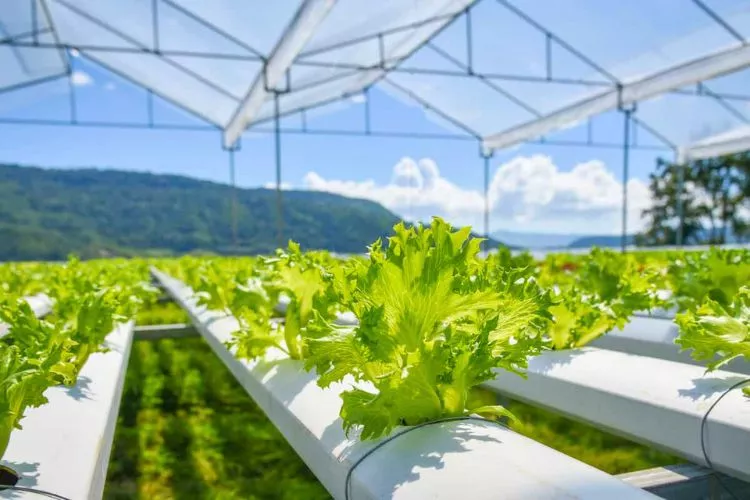
Water-related tips
- Utilize top-notch water: The quality of water can greatly influence plant well-being. Ensure you are using uncontaminated water that is suitable for hydroponic purposes.
- Regularly check water levels: Consistently monitoring the water levels in your hydroponic setup is vital. Confirm that water levels remain steady and roots always stay submerged.
- Select suitable grow mediums: The growing medium you opt for can also impact your hydroponic system’s water levels. Certainly, grow mediums hold more water than others, so opt for the one most suitable for your plant variety.
Nutrient-related tips
- Opt for premium nutrients: First-rate nutrients are crucial for the progress and maturation of your hydroponic plants. Ensure you’re utilizing nutrients that are designed especially for hydroponic applications.
- Monitor nutrient levels and pH balance frequently: Nutrient levels and pH balance can fluctuate quickly in a hydroponic system. Monitor them regularly to ensure your plants get the right nutrients in the right amounts.
- Provide adequate nutrient delivery: Ensure your nutrient delivery system is working correctly and nutrients are being delivered to your plants consistently.
Environmental tips
- Keep an eye on temperature and humidity: Temperature and humidity can influence plant well-being. Make sure you’re upholding ideal levels for your specific plant varieties.
- Employ suitable lighting for your plants: Various plant types have distinct lighting requirements. Ensure you’re offering your plants the proper quantity and kind of light.
Pest and disease-related tips
- Inspect plants regularly: Regular plant inspections can help you catch pests and diseases early before they have a chance to spread and cause serious damage.
- Use appropriate pest and disease control methods: If you encounter pests or diseases in your hydroponic system, ensure you’re using appropriate control methods that won’t harm your plants or compromise the safety of your hydroponic system.
Root-related tips
- Select suitable growth mediums: Choosing the correct growth medium can help in fostering healthy root development. Opt for a medium that promotes excellent water and nutrient retention and facilitates proper root aeration.
- Ensure correct water and nutrient levels: Proper water and nutrient levels are vital for thriving root growth. Ensure you’re upholding consistent levels and delivering the appropriate water and nutrients for your plant varieties.
Frequently Asked Questions (FAQs)
What should I do if my hydroponic plants are overwatered?
If your hydroponic plants receive too much water, the initial action is to halt the watering process and let the growth medium dry. Should the problem continue, modifying your watering routine or changing the growth medium employed might be necessary.
Can wilting be a sign of nutrient deficiencies?
Wilting can indicate nutrient deficiencies, particularly if the leaves are yellowing or browning. Monitor nutrient levels and adjust as needed.
What can I do if my hydroponic plants are affected by pests?
If your hydroponic plants suffer from pest infestations, examine them frequently and apply appropriate pest management techniques, like incorporating helpful insects or employing organic or chemical remedies. Avoidance is crucial, so keep a sanitary cultivation area and evade the introduction of pests through tainted tools or plants.
Conclusion:
In summary, keeping your hydroponic plants in optimal condition necessitates diligence and foresight. We have discussed prevalent reasons for wilting, strategies to avoid it, and ways to address it.
Don’t forget to utilize top-notch water and nutrients, frequently check their quantities, and frequently examine your plants. By following these suggestions, you can guarantee a flourishing hydroponic garden.
We believe this guide on hydroponic plants wilting has provided valuable insights. Our website features more content on related subjects. Do visit us again shortly for additional information.


